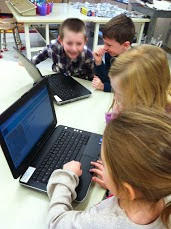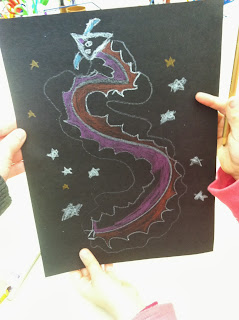As we wrap up September, we're also wrapping up our unit on Line. All grade levels did several projects on line and the kids are ready to move on. I'm confident that they will not forget their lessons in using Line and hopefully we can incorporate Line into the projects that we do with Shape in our next unit!

For our last Line hurrah in first grade, we made Line Dragons. The kids got so imaginative with these dragons, it was cool to see the different lines they used and also the different features they added to their dragons.

Students were given a black piece of paper with a white squiggle line already drawn down the middle for them. We spent a wee bit of time talking about Lines for review but then we moved right into drawing! Students picked a Line to use and followed the curve or their squiggly line with their Line on both sides, creating the body of their dragon. They used a white crayon to do this.
Then students colored the dragons body in with metallic colored pencils. And then they added whatever features they wanted to their dragons; wings, fire, stars, a moon, claws, horns, teeth... You name it, they did it!
Although this project was so simple, the kids really got excited about it and we were able add another layer to our discussion about the importance of Line in artwork. Using Line isn't just about drawing a bumpy line or a zig-zag line, it's about using line to create shapes and other images in your artwork. I think they're getting the connection!
Also the art room is putting out a monthly newsletter (at the end of the month since I had a hard time getting going at first!). This is to keep parents up to date about what their kids are being taught and to make them aware of the art room and it's importance. The document is pretty simple but hopefully effective! Take a peak...
Art Room Newsletter



















































